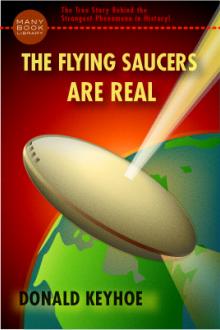The Flying Saucers are Real by Donald Keyhoe (best classic novels .TXT) 📕

- Author: Donald Keyhoe
- Performer: -
Book online «The Flying Saucers are Real by Donald Keyhoe (best classic novels .TXT) 📕». Author Donald Keyhoe
But the mysterious object had completely vanished in
{p. 42}
those few minutes. A search covering a hundred miles failed to reveal a trace.
Whether at a high or low altitude, a balloon could not have escaped the pilot’s eyes. It would also have continued to be seen at Godman Field and other points, through occasional breaks in the clouds.
I pointed out these facts to one Air Force officer at the Pentagon. Next day he phoned me:
“I figured it out. The timing device went off and the balloon exploded. That’s why the pilot didn’t see it.”
“It’s an odd coincidence,” I said, “that it exploded in those five minutes after Mantell’s last report.”
“Even so, it’s obviously the answer,” he said.
Checking on this angle, I found:
1. No one in the Kentucky area had reported a descending parachute.
2. No cosmic-ray research instrument case or parachute was found in the area.
3. No instruments were returned to the Navy from this region. And all balloons and instruments released at that time were fully accounted for.
Even if it had been a balloon, it would not explain the later January 7th reports—the simultaneous sightings mentioned by Professor Hynek in the Project “Saucer” report. This includes the thing seen at Lockbourne Air Force Base two hours after Mantell’s death.
Obviously, the saucer seen flying at 500 m.p.h. over Lockbourne Field could not have been a balloon. Even if there had been several balloons in this area (and there were not, by official record), they could not have covered the courses reported. In some cases, they would have been flying against the wind, at terrific speed.
Then what was the mysterious object? And what killed Mantell?
Both the Air Force and the Post articles speculate that Mantell carelessly let himself black out.
Since some explanation had to be given, this might seem a good answer. But Mantell was known for coolheaded judgment. As a wartime pilot, he was familiar with signs of anoxia (oxygen starvation). That he knew his tolerance for altitude is proved by his firmly declared
{p. 43}
intention to abandon the chase at 20,000 feet, since he had no oxygen equipment.
Mantell had his altimeter to warn him. From experience, he would recognize the first vague blurring, narrowing of vision, and other signs of anoxia. Despite this, the “blackout” explanation was accepted as plausible by many Americans.
While investigating the Mantell case, I talked with several pilots and aeronautical engineers. Several questioned that a P-51 starting a dive from 20,000 feet would have disintegrated so thoroughly.
“From thirty thousand feet, yes,” said one engineer. “If the idea was to explain it away, I’d pick a high altitude to start from. But a pilotless plane doesn’t necessarily dive, as you know.
“It might slip off and spin, or spiral down, and a few have even landed themselves. Also, if the plane started down from twenty thousand, the pilot wouldn’t be too far blacked out. The odds are he’d come to when he got into thicker air—admitting he did blur out, which is only an Air Force guess. I don’t see why they’re so positive Mantell died before he hit the ground—unless they know something we don’t.”
One of the pilot group put it more bluntly.
“It looks like a cover-up to me. I think Mantell did just what he said he would—close in on the thing. I think he either collided with it, or more likely they knocked him out of the air. They’d think he was trying to bring them down, barging in like that.”
Even if you accept the blackout answer, it still does not explain what Mantell was chasing. it is possible that, excited by the huge, mysterious object, he recklessly climbed beyond the danger level, though such an act was completely at odds with his character.
But the identity of the thing remains—officially—a mystery. If it was some weird experimental craft or a guided missile, then whose was it? Air Force officers had repeatedly told me they had no such device. General Carl Touhy Spaatz, former Air Force chief, had publicly insisted that no such weapon had been developed in his regime. Secretary Symington and General Hoyt Vandenberg,
{p. 44}
present Air Force chief, had been equally emphatic. Of course, official denials could be expected if it were a top-level secret. But if it were a secret device, would it be tested so publicly that thousands would see it?
If it were an Air Force device, then I could see only one answer for the Godman Field incident: The thing was such a closely guarded secret that even Colonel Hix hadn’t known. That would mean that most or all Air Force Base C.O.‘s were also in ignorance of the secret device.
Could it be a Navy experiment, kept secret from the Air Force?
I did a little checking.
Admiral Calvin Bolster, chief of aeronautics research experimental craft, was an Annapolis classmate of mine. So was Captain Delmer S. Fahrney, head of the Navy guided-missile program. Fahrney was at Point Mugu, missile-testing base in California, and I wasn’t able to see him. But I knew him as a careful, conscientious officer; I can’t believe he would let such a device, piloted or not, hover over an Air Force base with no warning to its C.O.
I saw Admiral Bolster. His denial seemed genuine; unless he’d got to be a deadpan poker player since our earlier days, I was sure he was telling the truth.
The only other alternate was Russia. It was incredible that they would develop such a device and then expose it to the gaze of U.S. Air Force officers. It could be photographed, its speed and maneuverability checked; it might crash, or antiaircraft fire might bring it down, The secret might be lost in one such test flight.
There was one other explanation: The thing was not intended to be seen; it had got out of control. In this event; the long hovering period at Godman Field was caused by the need for repairs inside the flying saucer, or repairs to remote-control apparatus.
If it were Air Force or Navy, that would explain official concern; even if completely free of negligence, the service responsible would be blamed for Mantell’s death. If it were Russian, the Air Force would of course try to conceal the fact for fear of public hysteria.
But if the device was American, it meant that Project
{p. 45}
“Saucer” was a cover-up unit. While pretending to investigate, it would actually hush up reports, make false explanations, and safeguard the secret in every possible way. Also, the reported order for Air Force pilots to pursue the disks would have to be a fake. Instead, there would be a secret order telling them to avoid strange objects in the sky.
By the time I finished my check-up, I was sure of one thing: This particular saucer had been real.
I was almost positive of one other point-that the thing had been over 30 miles high during part of its flight. I found that after Mantell’s death it was reported simultaneously from Madisonville, Elizabethtown, and Lexington—over a distance of 175 miles. (Professor Hynek’s analysis later confirmed this.)
How low it had been while hovering over Godman, and during Mantell’s chase, there was no way to determine. But all the evidence pointed to a swift ascent after Mantell’s last report.
Had Mantell told Godman Tower more than the Air Force admitted? I went back to the Pentagon and asked for a full transcript of the flight leader’s radio messages. I got a quick turn-down. The reports, I was told, were still classified as secret. Requests for pictures of the P-51 wreckage, and for a report on the condition of Mantell’s body, also drew a blank. I had heard that some photographs were taken of the Godman Field saucer from outside the tower. But the Air Force denied knowledge of any such pictures.
Puzzling over the riddle, I remembered John Steele, the former Intelligence captain. If by any chance he was a plant, it would be interesting to suggest the various answers and watch his reaction. When I phoned him to suggest luncheon, Steele accepted at once. We met at the Occidental, on Pennsylvania Avenue. Steele was younger than I had expected—not over twenty-five. He was a tall man, with a crew haircut and the build of a football player. Looking at him the first time, I expected a certain breeziness. instead, he was almost solemn.
“I owe you an apology,” he said in a careful voice after
{p. 46}
we’d ordered. “You probably know I’m a syndicate writer?”
I wondered if he’d found out Jack Daly was checking on him.
“When you mentioned the Press Club,” I said, “I gathered you were in the business.”
“I’m afraid you thought I was fishing for a lead.” Steele looked at me earnestly. “I’m not working on the story—I’m tied up on other stuff.”
“Forget it,” I told him.
He seemed anxious to reassure me. “I’d been worried for some time about the saucers. I called you that night on an impulse.”
“Glad you did,” I said. “I need every tip I can get.”
“Did it help you any?”
“Yes, though it still doesn’t fit together. But I can tell you this: The saucers are real, or at least one of them.”
“Which one?”
“The thing Captain Mantell was chasing near Fort Knox, before he died.”
“Oh, that one.” Steele looked down at the roll he was buttering. “I thought that case was fully explained. Wasn’t he chasing a balloon?”
“The Air Force says it’s still unidentified.” I told him what I had learned. “Apparently you’re right—it’s either an American or a Soviet missile.”
“After what you’ve told me,” said Steele, “I can’t believe it’s ours. It must be Russian.”
“They’d be pretty stupid to test it over here.”
“You said it was probably out of control.”
“That particular one, maybe. But there have been several hundred seen over here. If they found their controls were haywire, they wouldn’t keep testing the things until they’d corrected that.”
The waiter came with the soup, and Steele was silent until he left.
“I still can’t believe it’s our weapon,” he said slowly. “They wouldn’t have Air Force pilots alerted to chase the things. And I happen to how they do.”
“There’s something queer about this missile angle,” I said. “That saucer was seen at the same time by people a
{p. 47}
hundred and seventy-five miles apart. To be that high in the sky, and still look more than two hundred and fifty feet in diameter, it must have been enormous.”
Steele didn’t answer for a moment.
“Obviously, that was an illusion,” he finally answered. “I’d discount those estimates.”
“Even Mantell’s? And the Godman Field officers’?”
“Not knowing the thing’s height, how could they judge accurately?”
“To be seen at points that far apart, it had to be over thirty miles high,” I told him. “It would have to be huge to show up at all.”
He shook his head. “I can’t believe those reports are right. It must have been sighted at different times.”
I let it drop.
“What are you working on now?” Steele asked, after a minute or two.
I said I hadn’t decided. Actually, I planned a trip to the coast, to interview pilots who had sighted flying disks.
“What would you do if you found it wasn’t a Soviet missile?” said Steele. He sounded almost too casual.
“If security was involved,





Comments (0)